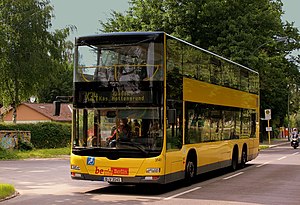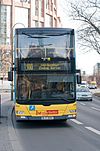|
Bus transport in Berlin
      Bus transport is the oldest public transport service in Berlin, the capital city of Germany, having been introduced in 1846. Since 1929, services have been operated by the Berlin Transport Company (German: Berliner Verkehrsbetriebe, BVG), although during the Cold War-era division of the city they operated in West Berlin only. In East Berlin the public transport agency split off from the BVG and rebranded as BVB, operating the buses in the Soviet sector of Berlin. Currently, the BVG's fleet consists of 1,550 vehicles, which cover 300,000 kilometres per day. As have many transit operators around the world, the BVG has set a goal to have their entire fleet running without emissions until 2030. For this reason the number of battery electric busses in Berlin is steadily rising.[1] History30 October 1846 saw the first bus services from the Concessionierte Berliner Omnibus-Compagnie. In 1868, a new company was created, the ABOAG (Allgemeine Berliner Omnibus Aktien Gesellschaft) which on 1 January 1929 merged with other Berlin public transport companies to create the BVG. After the opening of the Berlin Wall, the transport companies were no longer able to cope with the traffic, and so once again, solo buses by other transport companies and 100 hired coaches were used. The three-digit numbering system was unified and implemented on 2 June 1991, just before the reunification of BVG on 1 January 1992. RoutesNormal busesNormal bus routes ( Each bus line has a three-digit number. The second digit indicates the borough in which the line runs:
MetroBusAs for the MetroTram lines, there are 19 MetroBus ( The MetroBus routes are:[4]
Express busThe express buses ( The ExpressBus routes are:[4]
Night busesThe night buses (N)[6] consist of 40 lines and another nine lines to substitute (from N1 to N9) the U-Bahn (except at weekends). The N7X bus line is an express line, only serving stations with higher demand on its journey. The line can also only be taken in one direction towards the airport. The other lines serve suburban neighbourhoods not served by any public service running in daytime. The aforementioned U-Bahn substitution night bus lines are:[4]
Other services Apart from the service buses managed by BVG and other local companies, in the city there are hundreds of private tourist coaches. The main coach bus station of Berlin is the Zentraler Omnibusbahnhof Berlin ("Central Omnibus Station"), also known as ZOB.[7] It is located in Charlottenburg-Wilmersdorf and linked to the stations of Kaiserdamm (U-Bahn) and Messe Nord/ICC[8] (S-Bahn). In popular cultureOn 18 February 2011 MR Software released OMSI – The Bus Simulator (also known as OMSI – Der Omnibussimulator) for Windows. It is a bus simulator set in the late 1980s in West Berlin that features the MAN SD200 and MAN SD202 double-decker buses with a complex set of functions and made in various years. The player operates these buses along line 92 (now M37) that served the Staaken, Wilhelmstadt, Altstadt, and Falkenhagener Feld localities in the borough of Spandau. On 11 December 2013, MR Software released OMSI 2 – The Bus Simulator for Windows, the sequel to OMSI – The Bus Simulator. It features the MAN NL202 and the MAN NG272 in addition to the buses featured in OMSI (MAN SD200/SD202). The player can enjoy the bus lines 5 (now 130), 92 (now M37) and other add-ons which is community developed. It is sold on Aerosoft, Steam and Halycon. FleetAs of 2023, the BVG bus fleet consists of 1550 buses. Single-decker
Bendy bus or articulated bus
Double-decker bus
References
Literature
External linksWikimedia Commons has media related to Bus transport in Berlin. |
||||||||||||||||||||||||||||||||||||||||||||||||||||||||||||||||||||||||||||||||||||||||||||||||||||||||||||||||||||||||||||||||||||||||||||||||||||||||||||||||||||||||||||||||||||||||||||||||||||||||||||||||||||||||||||||||||||||||||||||||||||||||||||

























